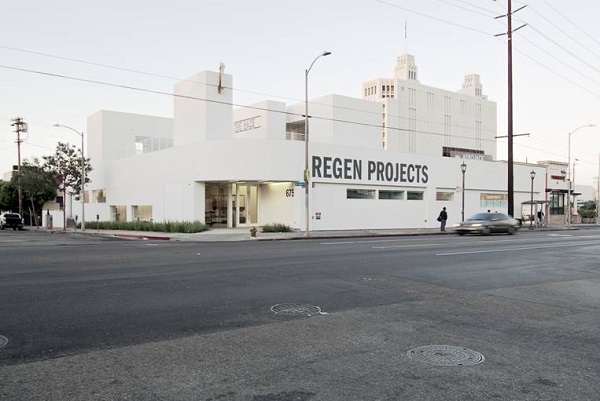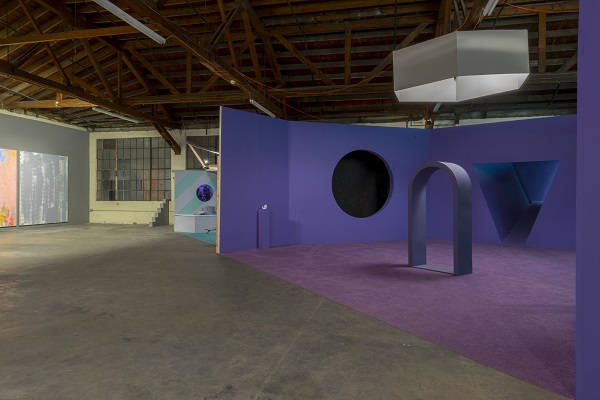Galleries
West Coast Gallerists Bet Big on Los Angeles’s East Side
Are LA galleries moving east in search of cheaper rent, or something more?

Are LA galleries moving east in search of cheaper rent, or something more?

Rozalia Jovanovic

Just a few years ago, there was an adage among Los Angeles gallerists that you couldn’t have a gallery east of La Cienega Boulevard in Culver City. Historically, the money has been on the west side of Los Angeles, in the wealthy enclaves of Beverly Hills and West Hollywood. To the east you’ll find areas like Hollywood and Downtown, a more diverse part of the city that encompasses industry, socio-economically mixed residential areas, and Skid Row, which boasts one of the country’s largest homeless populations. For at least the past decade, the triangle between Bergamot Station in Santa Monica, the La Cienega/Washington corridor and the arts district in Beverly Hills has represented the traditional gallery zone: Areas that offer pedestrians an art viewing experience to go along with their shopping and dining. In the past several years, however, galleries have been on the move, to the unorthodox eastern locales of East Hollywood and Downtown, which are luring visitors out of their cushy neighborhoods to the west. Is it a sign that the Los Angeles art world is maturing, or is this just a matter of course in the episodic and migratory nature of LA’s perennially de-centered gallery scene?
Eastward Ho
The eastward migration of galleries is largely credited to Shaun Regen, whose eponymous gallery Regen Projects—one of the oldest and most respected of LA’s galleries—moved to a 21,000 square foot space in East Hollywood a year-and-a-half ago from West Hollywood, where it had bounced around several spaces since its founding in 1989.
“Galleries have moved east in search of affordable rents and larger, more versatile spaces,” Regen told artnet News over email, explaining the eastbound trend. “Also, many collectors have moved east, or at least they have to follow the good shows, even if they still live on the west side.”
Following Regen Projects, many other galleries migrated east, including Perry Rubenstein (who represents the likes of Alex Katz and Mike Kelley), Hannah Hoffman Gallery (which just closed a group show with Talia Chetrit, Roe Ethridge, and Elad Lassry, and has an upcoming show with Sam Falls) and Redling Fine Art (which shows Liz Glynn and 2014 Whitney Biennial artist Dashiell Manley). Others, like Michael Kohn, and cool but scrappier Venice Beach gallery Various Small Fires (which represents Liz Magic Laser) are on the way. It’s even been said that London/Berlin gallery Sprueth Magers, which is opening a gallery in Los Angeles this year, has been looking in Hollywood. Dealer Philomene Magers has likened LA to Berlin calling it “an artist’s city.” David Kordansky is moving from its Culver City digs to a space on La Brea between Culver City and Hollywood.
“The Hollywood art scene is still in its infancy but I expect it will continue to grow for years to come,” Michael Kohn said over email. He’s moving from West Hollywood to a new 12,000 square foot gallery space in Hollywood in May with 22-foot ceilings and windows that look out onto Highland Avenue. “It’s a natural progression as far as art and the city are concerned. Galleries need a lot of space, and as inexpensively as possible. Yet they need to be located in urban areas, relatively close to where their patrons live. West Hollywood served that purpose for a long time, but it’s become expensive and less able to accommodate new growth.”
While it is possible for younger, smaller galleries to move to Hollywood, getting a lot of space there is still a tricky proposition. LA’s art scene has historically been decentralized, unlike New York’s, and proximity to patrons has been a perpetual concern. Yet some are beginning to branch out, eschewing the tonier locales in search of larger, cheaper, and more unique spaces, believing that if they create something sufficiently interesting, the patrons will beat a path to them.
Space on a Shoestring
“I came across a space Downtown by my friends Night Gallery,” said art dealer Francois Ghebaly, who opened his new Downtown space nine months ago after moving from a much smaller space in chic Culver City. “For under $1 a square foot, I could get a space that is absolutely magnificent. Why get a 3,000 square-foot space when you can get a 10,000-square-foot space for the same price?”
Ghebaly opened his first gallery in 2009 in Chinatown, a neighborhood that at the time was one of the “big important” art neighborhoods in the city. But after the financial crisis, most galleries there closed shop and dealers, Ghebaly among them, were on the lookout for new neighborhoods to move into. Ghebaly identifies Mara McCarthy, whose gallery The Box moved from Chinatown to Downtown in 2012, as one of the key players kicking off the easterly shuffle. Ghebaly initially moved to Culver City, to join the ranks of David Kordansky and Blum and Poe (the gallery that anchored Culver City when it moved there in 2003). But after three years in just under 1,000 square feet of space, he decided the space was too small and the rent, at $3 per square foot, too steep. Downtown provided the right mix of price and space.
“You can find stuff for $0.20 a square foot, for $1 a foot or $2-$2.50,” said Tyler Stonebreaker about Downtown. Creative Space, a real estate company Stonebreaker co-founded, lists on its website clients including Gavin Brown’s Enterprise and Maccarone (after publication of this article, Gavin Brown’s Enterprise and Maccarone have been removed from the list of clients on the website), both of which are Downtown (in Brown’s case 356 South Mission, an affiliate of his New York gallery, while Maccarone’s space will open in 2015). “Any kind of gallery space isn’t going to be attractive north of that [price range].”

Scott Reeder, installation view from 356 S. Mission Road, Los Angeles, March 25 – April 6, 2014.
Photo: Joshua White/JWPictures.com. Courtesy the artist and 356 S. Mission Road.
Comparatively speaking, at $4-$6 per square foot in West Hollywood, $3-$4 in Culver City, $3.50-$4.50 per square foot on La Brea, where David Kordansky is opening shop later this year, and Hollywood where it’s roughly $2.50-$4 a square foot, Downtown is a steal.
But cost isn’t the only factor pushing the eastward migration. “Big collectors have told me that before the GPS era, having a space where we are now, which is kind of off the beaten path, would be difficult because you had to take the Thomas Guide out—which is basically a phone book with the maps of the streets of LA,” Ghebaly said, noting that collectors were not that excited about taking the drive up to his old space in Chinatown. “But now, with GPS, you just plug in your GPS, and you’re a half-hour away from everything in the city.” Ghebaly also noted that the Uber app (which allows people to arrange for a car service pick-up with a few simple commands on their smart phone), is yet another positive change in the car-centric city.
Lauri Firstenberg, the director of LAXART, the only non-profit art space in Culver City, says the diffusion of cultural centers is a natural phenomenon in Los Angeles, because of “the sprawl.” LAXART recently struck up a programming partnership with Alameda Square for use of space within their new development, a creative industries complex which aims to make Downtown more accessible to the public and will house corporate headquarters for fashion brands like Splendid and American Apparel. “Usually when it happens,” says Firstenberg about gallery movement, which she says runs on a 5-10 year cycle, “it’s not on a permanent basis, but on a temporary basis. That’s how LA functions.”
Blue Chip Goes “Weird and Dirty”
The presence of larger and more established galleries Downtown, like 356 Mission, the hot Gavin Brown’s Enterprise affiliate run by artist Laura Owens, and Michele Maccarone’s forthcoming space indicate that the area is less wooly and more accessible than it might have once been. Downtown spaces also come with the cachet of having housed artists’ studio spaces in the 1970s and 80s—like Paul McCarthy, who lived and worked in east Downtown. Neighborhoods in the east like Pasadena, Glendale, Silverlake, and Eagle Rock are also popular with artists. As long as you’re willing to opt for an unrenovated space that might have cracked concrete floors and exposed insulation, the buildings you’ll find are simply more interesting than anything you’ll stumble on walking through Beverly Hills.
“In Los Angeles, being isolated is always a challenge,” said Firstenberg. “Now there are a lot of galleries following Laura [Owens] Downtown, or Regen Projects.” She also notes that with so many galleries moving to Hollywood, the prices in Hollywood have gone up in the past few years. Yet space is still cheaper in Hollywood than in New York. “We have a sister organization on the LES,” she said, “and they’re paying $8,000–10,000 in rent per month and don’t have money to program. We pay $2,000 per month in LA and all of our money goes to programming.”
One established LA gallerist drew a parallel between the Downtown art diaspora in LA and the influx of galleries to one neighborhood in New York. “It’s like when the first people went to Chelsea in the mid-90s,” he said. “There was space to realize more ambitious projects.”
“If you want a pedestrian-oriented gallery experience,” Stonebreaker explained, “where people in a particular area happen to be going to a restaurant or going shopping, and stumble upon a gallery—that’s a totally different mindset and experience than ‘You’ve got to get in your car, you’ve got to get off some weird road, go down a weird street, and there’s some vacant-looking warehouse building, non-descript with no signage and no parking or anything around it. All of a sudden you walk in and see this amazing Laura Owens exhibit, which was 356 Mission Road for her painting opening, and you go, holy crap, this is really cool.’ And you find out it was Liberace’s piano storage building.” While he notes that the appeal of such experiences is lost on people who find that type of space “weird and dirty and doesn’t really conjure buying million dollar pieces of art,” to others, including certain buyers, he says, “that’s really cool.”
With the new eastward trend, what will become of once-cool Culver City? Asked whether she thought Culver City was over, Firstenberg said: “Every time someone says that to me, and we think about what the future holds, in 5 years, 10 years—if you ask is Culver City over, but you have a thousand people coming to an opening to see an artist, that doesn’t seem over to me. Just like New York: The Upper East Side is not over; Chelsea’s not over; the Lower East Side’s not over. It’s just more contracted, and easier to get around.”